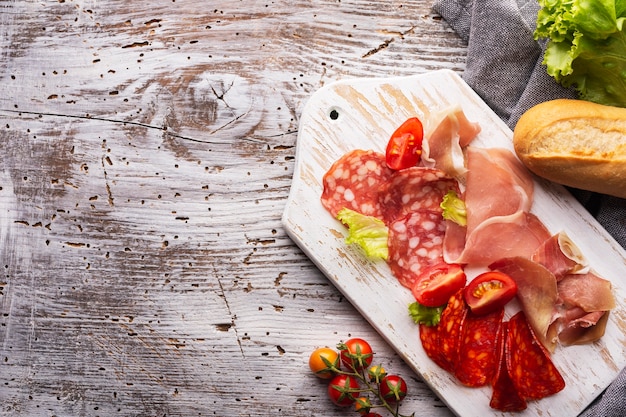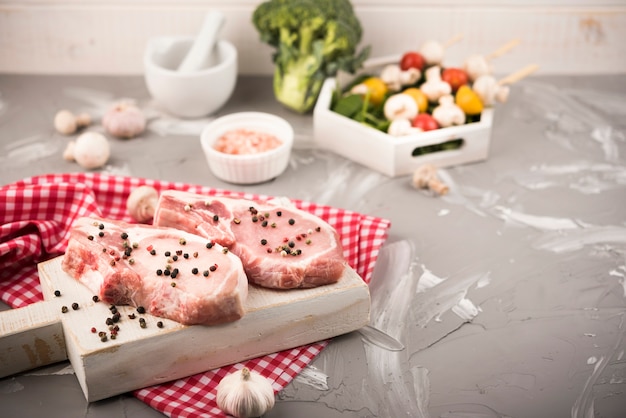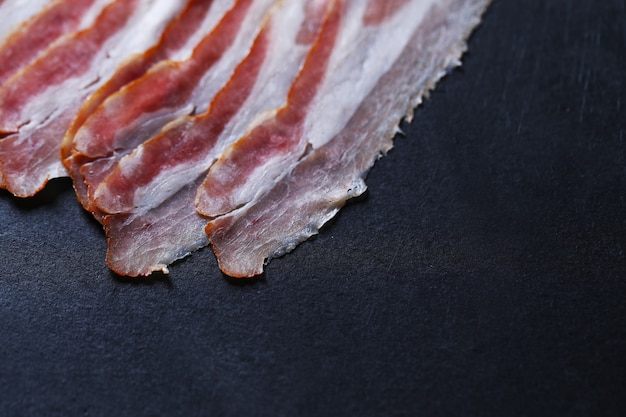Let's face it, we all love bacon. That crispy, salty goodness is a breakfast staple for many, and even makes a delightful appearance in lunches, dinners, and even desserts! But what happens when you're craving a bacon-filled treat and realize you haven't defrosted your bacon? Panic sets in, right? "Can I even cook it from frozen?" you wonder. The answer, my friend, is a resounding YES! And let me tell you, cooking bacon from frozen is a real lifesaver, especially on those mornings when a bacon butty is the only thing keeping you going.
Part 1: The Great Bacon Debate: Frozen vs. Fresh

Now, I know some people are purists when it comes to bacon. They'll swear by the flavor and texture of fresh bacon, freshly cooked. And you know what, they might have a point. There's something magical about that fresh, smoky scent that fills the air as the bacon sizzles in the pan. But when you're pressed for time, frozen bacon is a true game-changer. It's like having a little piece of bacon heaven waiting for you in the freezer, ready to be enjoyed whenever you need a fix.
The Advantages of Frozen Bacon
Let's talk about the perks of frozen bacon. First and foremost, it's insanely convenient. No more stressing over defrosting it overnight or remembering to pull it out of the freezer hours before you need it. Plus, you can keep it in the freezer for ages, making it perfect for those moments when you've over-bought at the supermarket (guilty as charged!). Frozen bacon is also great for portion control. You can easily break off a few rashers, leaving the rest for another day. It's like having a little bacon buffet ready for you whenever you please!
The Challenges of Frozen Bacon
Alright, let's be real. Frozen bacon can be a little trickier to cook than fresh. It's not impossible, but it does take a little more attention and care to get it just right. It might take a bit longer to cook evenly, and you might need to adjust your cooking method. But don't worry, I'm about to spill all my secrets and show you exactly how to master the art of cooking frozen bacon!
Part 2: The Art of Cooking Bacon From Frozen

Alright, are you ready to embark on this bacon-filled adventure? You've got your frozen bacon, you've got your kitchen, you've got the will! Let's get cooking!
Method 1: The Oven
This is my personal favorite method for cooking bacon from frozen. It's hands-off, easy, and consistently delivers perfectly crispy bacon, every single time. Here's how to conquer the oven method:
- Preheat your oven to 190°C (375°F). You want that oven nice and hot to ensure even cooking.
- Line a baking tray with baking parchment. This is crucial! It prevents the bacon from sticking and makes cleanup a breeze.
- Arrange the frozen bacon rashers in a single layer on the baking tray. Don't crowd them! Give them some space to breathe and cook evenly.
- Bake for 20-25 minutes, or until crispy. Keep an eye on it after about 15 minutes to make sure it's not burning. You know you want crispy, not charred!
- Remove from the oven and let it rest for a couple of minutes. This helps the bacon crisp up even further and allows the grease to settle.
Method 2: The Skillet
If you're short on oven space or just want to whip up a smaller batch of bacon, the skillet method is your friend. Here's how to rock it:
- Heat a non-stick skillet over a medium-high heat. You want that skillet good and hot before adding the bacon.
- Add the frozen bacon rashers to the skillet. You might need to do this in batches to avoid overcrowding the skillet.
- Cook for 5-7 minutes per side, or until crispy. Flip those rashers regularly to ensure even cooking.
- Remove from the skillet and drain on paper towels. This helps soak up any excess grease, leaving you with a crispy, delicious bacon treat.
Method 3: The Air Fryer
Air fryers are all the rage these days, and for good reason! They're super fast, cook food evenly, and are perfect for small batches of bacon. Here's how to make your air fryer work its magic on frozen bacon:
- Preheat your air fryer to 190°C (375°F).
- Place the frozen bacon rashers in the air fryer basket. Don't overload the basket!
- Cook for 5-7 minutes, flipping halfway through. Keep a close eye on it to avoid burning.
- Remove from the air fryer and let it rest for a couple of minutes. This gives the bacon a chance to crisp up even more.
Part 3: Tips and Tricks for Perfect Frozen Bacon

So, you've got the basic methods down. But what about those little secrets that can elevate your frozen bacon from good to absolutely amazing? Here are a few tips and tricks I've learned over the years.
1. Don't overcrowd your pan or baking tray.
Give those bacon rashers some breathing room! Crowding them together traps steam, leading to soggy bacon instead of crispy perfection.
2. Flip them regularly.
Whether you're using a skillet, oven, or air fryer, flip your bacon regularly to ensure even cooking. This prevents some parts from getting overly crispy while others remain soft.
3. Drain the grease.
Bacon releases a lot of grease while cooking, and this can make it soggy if not drained properly. After cooking, remove the bacon from the pan and drain it on paper towels. You can also add a layer of paper towels to the top of the bacon while it's cooking to absorb some of the grease.
4. Don't overcook it.
Keep a watchful eye on your bacon to avoid burning it. It's better to slightly undercook it than to char it to a crisp. You can always cook it a little longer if it's not quite done to your liking.
5. Consider the thickness.
The thickness of the bacon will affect cooking time. Thicker bacon takes longer to cook than thinner bacon. If you're unsure, check the packaging for cooking guidelines.
Part 4: What to Do with Your Crispy Bacon
Okay, you've got your perfectly cooked bacon. Now what? The possibilities are endless! Let's explore some of the many delicious ways to enjoy your bacon masterpiece.
bacon butties
Let's be honest, the classic bacon butty is a must-have. Pile your crispy bacon onto a slice of buttered bread, add a bit of ketchup or brown sauce, and you're in for a treat. It's the ultimate comfort food, simple yet incredibly satisfying.
Bacon and Eggs
A classic for a reason. scrambled eggs, fried eggs, poached eggs – whatever your preference, bacon makes the perfect companion. I love to add a bit of cheese and avocado for extra goodness.
bacon salad
Don't underestimate the power of a good bacon salad! Crumble your bacon over a bed of lettuce, add some cherry tomatoes, cucumber, and a light vinaigrette dressing. So refreshing and delicious!
Bacon-Wrapped Everything
Seriously, there's nothing bacon can't wrap up and make delicious! Chicken, fish, sausages, even vegetables – wrap 'em up and bake or grill for an extra layer of flavour.
Bacon for Snacks
Bacon is the ultimate snack! It's perfect on its own, or you can add it to crackers, cheese boards, and even popcorn. Get creative and let your bacon cravings run wild!
Part 5: The Science of Bacon
You might be wondering, why is bacon so darn delicious? Well, it's all thanks to science! Bacon is made from pork belly, which is a very fatty cut of meat. This fat is what gives bacon its juicy texture and melt-in-your-mouth flavor. During cooking, the fat renders out, leaving behind crispy bits of bacon that are both satisfying and flavorful.
The Maillard Reaction
One of the key things that makes bacon so irresistible is the Maillard reaction. This is a chemical reaction that happens when sugars and amino acids in meat are heated. It produces hundreds of different flavor compounds, giving bacon its unique aroma and taste. That's why crispy bacon is so much more flavorful than soft, undercooked bacon. The Maillard reaction is the magic behind bacon's captivating taste.
Nitrates and Nitrites
Bacon also contains nitrates and nitrites, which are added to cure the meat and preserve its color. These chemicals contribute to the flavor of bacon, giving it that signature smoky taste. While there are some health concerns surrounding nitrates and nitrites, they are generally considered safe in small amounts.
Part 6: The Controversies of Bacon
Let's be real. Bacon isn't exactly health food. It's high in fat, sodium, and calories. It's also been linked to an increased risk of certain cancers. But I'm not here to preach. I'm a bacon lover at heart, and I know many of you are too. So, let's talk about ways to enjoy bacon in moderation and make healthier choices.
Healthier Bacon Options
There are some healthier options out there, like turkey bacon or veggie bacon. These versions are lower in fat and calories than traditional bacon. If you're looking for a healthier version of regular bacon, you can try cooking it with less fat or choosing a leaner cut.
Moderation is Key
The key is moderation. Don't eat bacon every day, and try to choose leaner cuts when you do. And don't forget, bacon is best enjoyed in small quantities. It's all about balance, right?
Part 7: Bacon Around the World
Bacon isn't just a British staple, it's a global phenomenon! Different cultures have their own unique takes on bacon, from the thick-cut, smoky bacon of the United States to the thin, crispy bacon of Japan.
Bacon Around the UK
Here in the UK, bacon is a true national treasure. We love it in all its forms, from the classic streaky bacon to the thicker back bacon. We use it in everything from breakfast sandwiches to Sunday roasts. It's truly a versatile ingredient!
Bacon Around the World
Here are some examples of bacon from around the world:
| Country | Type of Bacon | Description |
|---|---|---|
| United States | thick-cut bacon | Thick slices of bacon, often smoked with hickory wood, known for its rich flavor and satisfying chew. |
| Japan | Thin Bacon | Thin slices of bacon, often used in stir-fries and other Asian dishes, adding a savory and salty element. |
| France | Lardons | Small, diced bacon, often used in soups and salads, adding a smoky depth to french cuisine. |
| Germany | Speck | A type of cured and smoked bacon, often used in sandwiches and salads, known for its intense smoky flavor. |
| Italy | Pancetta | A type of unsmoked bacon, often used in pasta dishes and sauces, offering a delicate salty flavor. |
Part 8: Bacon Beyond Breakfast
Bacon isn't just for breakfast, you know! It's a versatile ingredient that can be enjoyed at any meal of the day. Let's explore some of the ways bacon can elevate your culinary experience beyond the morning hours.
Lunchtime Bacon
For a quick and easy lunch, try a bacon and cheese sandwich or a bacon salad. You can also add bacon to your favorite soups and stews for an extra layer of flavor. Bacon adds a satisfying crunch and smoky depth to any lunchtime meal.
Dinnertime Bacon
Bacon is a great addition to any dinner! You can wrap it around chicken or fish for a delicious and flavorful meal. Or, simply crumble it over your favorite pasta dishes or pizzas. Bacon brings a salty, smoky twist to dinnertime, making even simple dishes feel special.
Bacon for Dessert
Yes, you heard that right! Bacon can be used in desserts. It adds a salty, savory element to sweet treats like chocolate chip cookies, ice cream sundaes, and even cheesecakes. The unexpected combination of sweet and savory creates a unique and delicious taste sensation.
Part 9: FAQs About Frozen Bacon
Let's address some of your most burning questions about frozen bacon.
1. Is frozen bacon as good as fresh bacon?
It depends on your preference! Some people prefer the taste and texture of fresh bacon, while others find frozen bacon to be just as good. Ultimately, it comes down to your own taste buds. If you're short on time or just prefer the convenience of frozen bacon, don't hesitate to use it.
2. How long can you keep bacon in the freezer?
You can safely keep bacon in the freezer for up to 2 months. Just make sure to wrap it tightly in plastic wrap or aluminum foil to prevent freezer burn.
3. Can you refreeze bacon?
It's generally not recommended to refreeze bacon once it has been thawed. This is because freezing and thawing can affect the texture and flavor of the bacon. If you've already thawed bacon, it's best to cook it and enjoy it as soon as possible.
4. What's the best way to thaw bacon?
The best way to thaw bacon is in the refrigerator. Place the bacon in a sealed container or plastic bag and allow it to thaw for several hours or overnight. You can also thaw bacon quickly by placing it in a bowl of cold water. Just make sure to change the water every 30 minutes.
5. Can I cook bacon from frozen in the microwave?
I wouldn't recommend it. Cooking bacon in the microwave can result in uneven cooking and a rubbery texture. It's best to stick to the oven, skillet, or air fryer methods for cooking bacon from frozen.
Everyone is watching

How to Cook Frozen Lobster Tails Perfectly: A Step-by-Step Guide
RecipesLobster. Just the word conjures up images of lavish meals, special occasions, and a taste of luxury. But let's...

Pigs in a Blanket Cooking Time: How Long to Bake for Perfect Results
RecipesAh, pigs in a blanket. Just the name conjures up images of those delightful little parcels of crispy pastry en...

Pork Fillet Cooking Time: How Long to Cook It Perfectly
RecipesPork fillet, or tenderloin as it's sometimes called, is a real favourite in our house. It's so versatile, and...

The Ultimate Guide to Cooking Delicious Frankfurters
RecipesLet's face it, we all love a good frankfurter. It's a classic, simple, and always satisfying. But let's be rea...

Wolf Meat Recipes: A Guide to Cooking Wild Game
RecipesLet's be honest, you don't see wolf meat at your local butcher shop every day. It's a bit of a wild card, but ...
